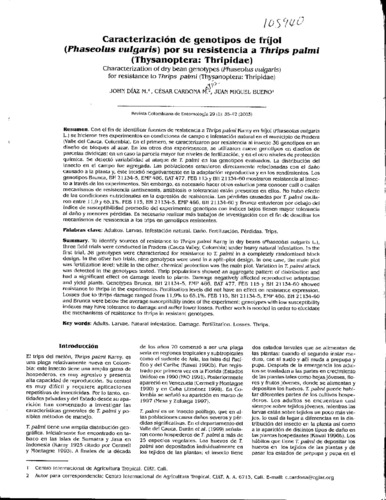Caracterización de genotipos de frijol (Phaseolus vulgaris) por su resistencia a Thrips palmi (Thysanoptera: Thripidae) = Characterization of dry bean genotypes (Phaseolus vulgaris) for resistance to Thrips palmi (Thysanoptera: Thripidae)
Con el fin de identificar fuentes de resistencia a Thrips palmi Karny en fríjol ( Phaseolus vulgaris L.) se hicieron tres experimentos en condiciones de campo e infestación natural en el municipio de Pradera (Valle del Cauca, Colombia). En el primero, se caracterizaron por resistencia al insecto 38 genotipos en un diseño de bloques al azar. En los otros dos experimentos, se utilizaron nueve genotipos en diseños de parcelas divididas; en un caso la parcela mayor fue niveles de fertilización, y en el otro niveles de protección química. Se detectó variabilidad al ataque de T. palmi en los genotipos evaluados. La distribución del insecto en el campo fue agregada. Las poblaciones estuvieron directamente relacionadas con el daño causado a la planta y, éste incidió negativamente en la adaptación reproductiva y en los rendimientos. Los genotipos Brunca, BH 21134-5, EMP 486, BAT 477, FEB 115 y BH 21134-60 mostraron resistencia al insecto a través de los experimentos. Sin embargo, es necesario hacer otros estudios para conocer cuál o cuáles mecanismos de resistencia (antixenosis, antibiosis o tolerancia) están presentes en ellos. No hubo efecto de las condiciones nutricionales en la expresión de resistencia. Las pérdidas causadas por T. palmi oscilaron entre 11,9 y 65,1%. FEB 115, BH 21134-5, EMP 486, BH 21134-60 y Brunca estuvieron por debajo del índice de susceptibilidad promedio del experimento; genotipos con índices bajos tienen mayor tolerancia al daño y menores pérdidas. Es necesario realizar más trabajos de investigación con el fin de descifrar los mecanismos de resistencia a los trips en genotipos resistentes. = To identify sources of resistance to Thrips palmi Karny in dry beans ( Phaseolus vulgaris L.), three field trials were conducted in Pradera (Cauca Valley, Colombia) under heavy natural infestation. In the first trial, 38 genotypes were characterized for resistance to T. palmi in a completely randomized block design. In the other two trials, nine genotypes were used in a split-plot design. In one case, the main plot was fertilization level; while in the other, chemical protection was the main plot. Variation in T. palmi attack was detected in the genotypes tested. Thrip populations showed an aggregate pattern of distribution and had a significant effect on damage levels to plants. Damage negatively affected reproductive adaptation and yield plants. Genotypes Brunca, BH 21134-5, EMP 486, BAT 477, FEB 115 y BH 21134-60 showed resistance to Thrips in the experiments. Fertilization levels did not have an effect on resistance expression. Losses due to Thrips damage ranged from 11,9% to 65,1%. FEB 115, BH 21134-5, EMP 486, BH 21134-60 and Brunca were below the average susceptibility index of the experiment; genotypes with low susceptibility indexes may have tolerante to damage and suffer lower losses. Further work is needed in order to elucidate the mechanisms of resistance to Thrips in resistant genotypes.

